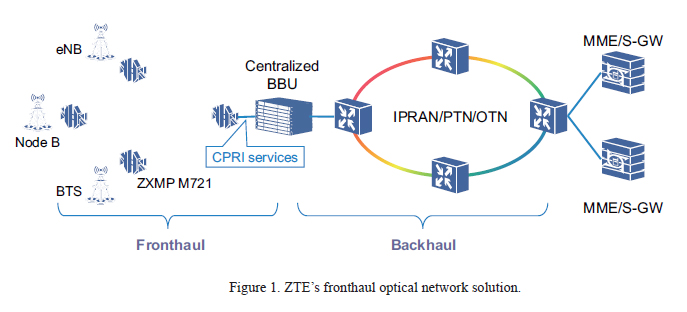Fronthaul Optical Network Solution Facilitates Widespread 4G Deployment
In the era of mobile internet, operators are facing the challenges of high Capex and Opex, rapid data traffic growth and slow ARPU increase in radio access networks (RAN). To meet growing demands for broadband services, operators continue to increase the bandwidth of air interfaces and the number of base stations (BS). The problem of energy consumption in RAN becomes increasingly serious, and the tidal effect also results in low average BS utilization rate.
In this context, operators have put forward the concept of energy-efficient network evolution, in which baseband units (BBUs) are centrally deployed to meet the needs of low cost, high capacity, low power consumption, and easy operations. The centralized BBU deployment can address the issues of difficult site acquisition, high construction and operation costs, and growing energy consumption when building LTE networks. Also, a BBU site can connect several remote radio units (RRUs) for sharing baseband resources. The key to centralized BBU deployment lies in building mobile fronthaul networks.
With the widespread commercial 4G deployment and continued service growth, the speed of fronthaul construction is increasingly important and will have a direct impact on whether operators can quickly seize the market. The fronthaul construction has placed three requirements on transport: high bandwidth, low delay, and high precision.
● High bandwidth: Now the maximum CPRI bandwidth of LTE base stations is up to 9.830 Gbps.
● Low delay: The CPRI standard requires the maximum distance of CPRI transport links should be no less than 10 km.
● High precision: The carrier frequency stability of BS air interfaces is better than ±0.05 ppm and the clock tracking precision is better than ± 0.002 ppm.
ZTE's fronthaul optical network solution adopts CPRI over OTN, which can solve the problems of fiber resource shortage, limited transport distance and lack of supervision in the traditional way of direct fiber connection (RRU and BBU are directly connected via optical fiber). The solution is suitable for centralized BBU deployment (Fig. 1).

The fronthaul solution is based on ZTE's OTN product ZXMP M721 that consists of ZXMP M721 OD61 and ZXMP M721 DX62 for CPRI transport. ZXMP M721 OD61 is an integrated box device deployed on the RRU side. It is also a new outdoor OTN device that features low cost and high integration and is energy efficient. The OD61 device meets the requirements of fronthaul construction for service access, transport, O&M, energy saving and emission reduction. ZXMP M721 DX62 is a plug-in box device deployed on the BBU side (typically deployed indoors). It is only 2U high and can be stacked to connect with OD61.
ZTE's fronthaul optical network solution meets the requirements of fronthaul network construction for high bandwidth, low delay and high precision. The solution has the following attractions:
● Powerful service bearing capability: ZXMP M721 OD61 has a bandwidth of 30 Gbps or 60 Gbps (60 Gbps is the largest bandwidth in the industry). It supports CPRI option 2 to 8, STM-1/4/16, and GE, and can access 12-channel CPRI services at most. The OD61 device can also converge 6/12-channel CPRI services into 3/6-channel OTU2 signals. ZXMP M721 DX62 can access services with the rates ranging from 2 Mbps to 10 Gbps.
● Outstanding transport performance: Without any optical-electrical repeater, the maximum budget for the line between RRU and BBU is up to
15 dB. The end-to-end time delay introduced by devices is 15 μs, and a transport distance of 37 km can be supported.
● Flexible networking: ZXMP M721 supports point-to-point, chain and ring networking modes and also single-fiber bidirectional and dual-fiber bidirectional transport modes, which can meet various networking needs in a radio network. The single-fiber bidirectional transport mode is usually adopted for point-to-point networking. Each OTN system occupies only one fiber core, resulting in a substantial reduction in fiber resources. For chain and ring networking, the dual-fiber bidirectional transport mode is used. The ring networking can provide 1+1 protection at the line side, with a protection switching time less than 50 ms, which improves service security.
● Excellent clock performance: ZXMP M721 carries CPRI services, with the frequency offset value better than ±0.05 ppm and the clock tracking precision better than ±0.002 ppm.
● Perfect management information transport: ZXMP M721 supports OSC and ESC, allowing users to flexibly choose management information transport modes according to application scenarios. Two optical directions are supported at most.
● Flexible installation: ZXMP M721 OD61 is applicable to various outdoor conditions, meeting the requirements of IP65 standards. It can be used in ambient temperature ranging from –40°C to 55°C, and its lightning protection capability reaches class C. It also supports wall and pole mounted installation options. ZXMP M721 DX62 is generally used indoors, and supports IEC/ETS standard cabinets as well as wall mounted and outdoor cabinet installation options.
● Easy system commissioning and simple O&M: ZXMP M721 uses NetNumenTM U31, the general network management system for a full range of ZTE's OTN equipment, to implement remote fault management, performance management, security management, configuration management, maintenance management, and system management. Both ZXMP M721 OD61 and DX62 support DC and AC power supply. Moreover, ZXMP M721 DX62 supports high-voltage DC power supply, and ZXMP M721 OD61 supports the CLI-based system commissioning and maintenance that network O&M is not needed. ZXMP M721 OD61 can also be connected directly to the fiber, and supports WiFi debugging and convenient O&M. This guarantees the security of O&M personnel.
As LTE networks are commercially deployed on a large scale, centralized BBU deployment model—a new network architecture has emerged. In the centralized BBU deployment, fronthaul network construction is of great importance. ZTE's fast, easy, secure, and cost-effective fronthaul optical network solution will become the best choice for operators.